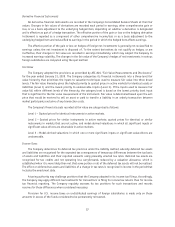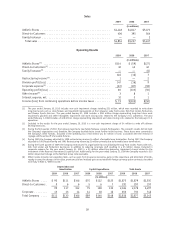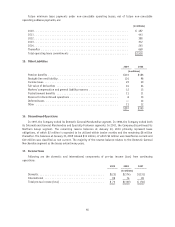Foot Locker 2009 Annual Report Download - page 54
Download and view the complete annual report
Please find page 54 of the 2009 Foot Locker annual report below. You can navigate through the pages in the report by either clicking on the pages listed below, or by using the keyword search tool below to find specific information within the annual report.Merchandise Inventories and Cost of Sales
Merchandise inventories for the Company’s Athletic Stores are valued at the lower of cost or market using
the retail inventory method. Cost for retail stores is determined on the last-in, first-out (‘‘LIFO’’) basis for
domestic inventories and on the first-in, first-out (‘‘FIFO’’) basis for international inventories. The retail inventory
method is commonly used by retail companies to value inventories at cost and calculate gross margins due to its
practicality. Under the retail inventory method, cost is determined by applying a cost-to-retail percentage across
groupings of similar items, known as departments. The cost-to-retail percentage is applied to ending inventory at
its current owned retail valuation to determine the cost of ending inventory on a department basis. The Company
provides reserves based on current selling prices when the inventory has not been marked down to market.
Merchandise inventories of the Direct-to-Customers business are valued at the lower of cost or market using
weighted-average cost, which approximates FIFO. Transportation, distribution center, and sourcing costs are
capitalized in merchandise inventories. The Company expenses the freight associated with transfers between its
store locations in the period incurred. The Company maintains an accrual for shrinkage based on historical rates.
Cost of sales is comprised of the cost of merchandise, occupancy, buyers’ compensation and shipping and
handling costs. The cost of merchandise is recorded net of amounts received from vendors for damaged product
returns, markdown allowances and volume rebates, as well as cooperative advertising reimbursements received in
excess of specific, incremental advertising expenses. Occupancy includes the amortization of amounts received
from landlords for tenant improvements.
Property and Equipment
Property and equipment are recorded at cost, less accumulated depreciation and amortization. Significant
additions and improvements to property and equipment are capitalized. Maintenance and repairs are charged to
current operations as incurred. Major renewals or replacements that substantially extend the useful life of an
asset are capitalized and depreciated. Owned property and equipment are depreciated on a straight-line basis
over the estimated useful lives of the assets: maximum of 50 years for buildings and 3 to 10 years for furniture,
fixtures and equipment. Property and equipment under capital leases and improvements to leased premises are
generally amortized on a straight-line basis over the shorter of the estimated useful life of the asset or the
remaining lease term. Capitalized software reflects certain costs related to software developed for internal use
that are capitalized and amortized. After substantial completion of a project, the costs are amortized on a
straight-line basis overa2to7year period. Capitalized software, net of accumulated amortization, is included as
a component of property and equipment and was $24 million and $23 million at January 30, 2010 and January 31,
2009, respectively.
Recoverability of Long-Lived Assets
The Company recognizes impairment losses whenever events or changes in circumstances indicate that the
carrying amounts of long-lived tangible and intangible assets with finite lives may not be recoverable.
Management’s policy in determining whether an impairment indicator exists, a triggering event, comprises
measurable operating performance criteria at the division level, as well as qualitative measures. The Company
considers historical performance and future estimated results, which are predominately identified from the
Company’s three-year strategic plans, in its evaluation of potential store-level impairment and then compares the
carrying amount of the asset with the estimated future cash flows expected to result from the use of the asset. If
the carrying amount of the asset exceeds the estimated expected undiscounted future cash flows, the Company
measures the amount of the impairment by comparing the carrying amount of the asset with its estimated fair
value. The estimation of fair value is measured by discounting expected future cash flows at the Company’s
weighted-average cost of capital. The Company estimates fair value based on the best information available
using estimates, judgments and projections as considered necessary.
Goodwill and Other Intangible Assets
The Company reviews goodwill and intangible assets with indefinite lives for impairment annually during the
first quarter of its fiscal year or more frequently if impairment indicators arise. The fair value of each reporting
unit is determined using a combination of market and discounted cash flow approaches.
36
























